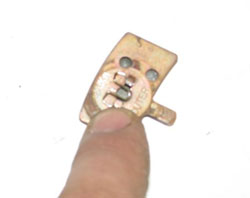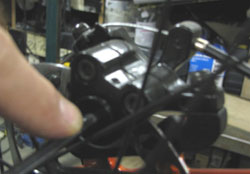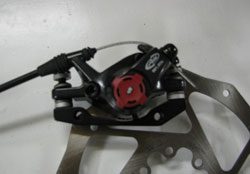Disc brakes are now found on mountain bikes of nearly every price point and they are quickly becoming the standard. Of the multitude of types and brands, disc brakes fall simply into one of two categories: hydraulic or mechanical disc brakes. Mechanical disc brakes are generally cheaper (cost-wise), but not necessarily cheaper in quality. Both systems, as wonderful as they are, do need periodic inspections much like the brakes on your car. Seeing that a fraction of riders use a computer on their bike, I personally recommend inspecting your brakes in number of rides. I propose that you thoroughly inspect your brakes every 25th ride at the very least, or if you feel a loss in braking performance.
Here I will cover adjusting and servicing mechanical disc brakes including exchanging brake pads, servicing rotors, checking and servicing cables, and ensuring the proper functionality of the braking system. Note: the following photos may not be the same as your brake set-up but they will represent most of the systems out there.
Before your get started you need to have the correct tools for the job. The list below are the typical tools required for inspecting and servicing your mechanical disc brakes.
- 3, 4, 5mm Allen sockets
- T25 socket
- Brake cable housing cutters
- 120gt sand paper
- Needle nose pliers
- Alcohol wipes to clean rotor of finger prints
- Torque wrench
Brake lever inspection
 One of the first things to inspect when you are servicing your mechanical disc brakes is the function of the brake lever and the calipers actuation lever. Apply and release the brake looking at the actuation arm (what the brake cable attaches to at the caliper). Check to see that it swings freely and does not hang up, that is, the arm returns to fully released position. If the arm does hang up, look for corrosion or possible obstructions. Usually some cleaning with penetrating oil followed by a thicker lubricant will loosen the arm. Now, check the movement of the brake lever itself. Apply and release the lever, it should be loose. Put a bit of lube on the pivot pin to ensure proper operation of the lever. Finally, torque the cable anchor bolt to 55 in-lbs +/- 5 in-lbs.
One of the first things to inspect when you are servicing your mechanical disc brakes is the function of the brake lever and the calipers actuation lever. Apply and release the brake looking at the actuation arm (what the brake cable attaches to at the caliper). Check to see that it swings freely and does not hang up, that is, the arm returns to fully released position. If the arm does hang up, look for corrosion or possible obstructions. Usually some cleaning with penetrating oil followed by a thicker lubricant will loosen the arm. Now, check the movement of the brake lever itself. Apply and release the lever, it should be loose. Put a bit of lube on the pivot pin to ensure proper operation of the lever. Finally, torque the cable anchor bolt to 55 in-lbs +/- 5 in-lbs.
Cable routing inspection
 Next, inspect the brake cable and the routing of the cable. Look for any fraying (loose strands of the cable) or kinking of the cable or housing. Consider replacing the cables and housing if there are frays or kinks found, otherwise you will risk poor braking performance on your next ride. Or, if the current brake cables have been on your bike for 2-3 years, it’s a good idea to replace them now. I recommend a quality sealed cable system like those available from Gore, Jagwire, or Avid.
Next, inspect the brake cable and the routing of the cable. Look for any fraying (loose strands of the cable) or kinking of the cable or housing. Consider replacing the cables and housing if there are frays or kinks found, otherwise you will risk poor braking performance on your next ride. Or, if the current brake cables have been on your bike for 2-3 years, it’s a good idea to replace them now. I recommend a quality sealed cable system like those available from Gore, Jagwire, or Avid.
Removal and replacement of brake cables
When replacing the brake cables, measure the lengths of the old cable and housings to determine the proper cable routing and new lengths. Err on the long side when cutting cables as the cable length should not be too short. If the cables are too short they will limit the full range of steering. Be cautious by replacing one cable at a time since the lengths of the front and rear brake cables are very different. When cutting cables use proper cable cutters that leaves a nice flush finish to the cable ends. Always use new cable ferrules (the steel ends) to finish your job, even these little steel ends wear out.
To remove the old cable, first loosen the bolt that holds the cable in place on the brake caliper, and then pull the cable out from the housing. Loosen the adjustment barrels on the brake lever and squeeze the brake lever so that the cable is exposed enough to remove it from the slotted hinge in the brake lever.
Tighten the cable adjustment barrel about two threads from all the way in and insert the new cable. Route the cable in the same way the old cable was routed. Try lubing the housing with a small amount of synthetic oil to get the cables through the housing if needed (do not add oil if you are using Gore or Avid Flak Jackets). Finally, attach the cable to the brake caliper and torque the cable anchor bolt to 55 in-lbs +/-5 in-lbs.
Removal and inspection of brake pads
 Before you get started on inspecting the brake pads, remove the wheel from the bike so you can better access the pads. Then remove the brake pads from the caliper to inspect their thickness and condition. Look for a minimum thickness of 1mm and check the condition of the pad making sure they are not galled or contaminated with grease or oil.
Before you get started on inspecting the brake pads, remove the wheel from the bike so you can better access the pads. Then remove the brake pads from the caliper to inspect their thickness and condition. Look for a minimum thickness of 1mm and check the condition of the pad making sure they are not galled or contaminated with grease or oil.
There are various methods of removing your brake pads and some brake pads are removed by unscrewing a pin out of the caliper allowing the pads to drop out. Other brakes may have a small clip that holds the pad to the pistons, and still others are held in place with a magnetic piston. If you are unsure how to remove the pads, check your brake manufacturer’s owners manual or website for details. Usually the device that holds the pads in place is opposite the way the pads come out of the caliper.
Brake pads that are thicker than 1mm may not need to be replaced but should be cleaned and sanded. Lay medium close coat sand paper on a flat surface, and with a circular motion lightly rub the brake pad on the sand paper for a few seconds at a time or until the pad surface is flat and uniform. Before you reinstall the pads quickly check that the thickness is still greater than 1mm. If your brake pads are less than 1mm thick, install new pads.
Remember that your brake pad may have a return spring (placed between the pads), a cotter pin or a bolt that holds t he pads in place. Otherwise, your system has a retaining spring on the back of your pad. Once you have finished servicing your pads or decided to replace them, you can install them into the caliper. One at a time, slide the pad back into the caliper paying attention to the alignment clips or holes that hold the retaining pin/clips. Then put in the retaining device in place (if you have a cotter pin remember to spread it out so the pin doesnt work its way free). Finally, give the pads a tug to make sure they do not fall out.
he pads in place. Otherwise, your system has a retaining spring on the back of your pad. Once you have finished servicing your pads or decided to replace them, you can install them into the caliper. One at a time, slide the pad back into the caliper paying attention to the alignment clips or holes that hold the retaining pin/clips. Then put in the retaining device in place (if you have a cotter pin remember to spread it out so the pin doesnt work its way free). Finally, give the pads a tug to make sure they do not fall out.
Rotor inspection and cleaning
The next task is to recondition the rotors by removing any glaze that may have accumulated on them. Remove the rotor if it is attached with T25 torx bolts or a Shimano centre lock. You can service the rotor while still attached to the wheel if you dont have the tools to remove the rotor from the hub, just be careful to keep your fingers clear.
Fold medium sandpaper around a straight block to create a flat sanding surface. Rub the sand paper tangentially on both sides of the rotors braking surfaces. Now the rotor should look new with cross hatching marks (small scratches) at 33 degree angles from one another.
If you removed the rotor from the wheel, reinstall the rotor and torque the bolts back at 55 60 inch-pounds. When applying torque to the bolts, it should be done evenly and not in a circular pattern. Last, clean the rotor off with a clean cloth and alcohol to remove any oil or fine metal particles. Replace your wheel and check the operation of the brakes.
Brake pad adjustment
 |
 |
Ideally the brake pad position should be set so that when the brake lever is depressed half way, the wheel should lock up. There should be very little space between the brake pads and rotor; this space should be about the thickness of a business card. This spacing can be adjusted on all mechanical disc brake systems using a dial or Allen key for the outboard pad (above, left) and adjusting cable tension for the inside pad. Some manufactures like Avid (above, right) have an inboard pad adjustment as well, again adjust the pad so that you have the space of a business card between them.
 Get the proper spacing on the outboard brake pad by making adjustments with the dial or Allen key. If the spacing is too wide on the inboard brake pad, use the adjustment barrel either on the caliper or the brake lever to take up the slack. A small turn of the adjustment barrel surprisingly changes the brake lever travel a lot.
Get the proper spacing on the outboard brake pad by making adjustments with the dial or Allen key. If the spacing is too wide on the inboard brake pad, use the adjustment barrel either on the caliper or the brake lever to take up the slack. A small turn of the adjustment barrel surprisingly changes the brake lever travel a lot.
Torque inspection
Once you have the pads adjusted, the rotors and pads cleaned, and your cables lubricated, check the amount of torque on your entire braking system, particularly the caliper bolts, caliper adapters, and the brake levers. Remember to always follow your specific brake manufacturers recommended torque settings. Use a torque wrench to make any needed adjustments.
Typical torque values:
International standard (I.S.) caliper mount bolts are 110 in-lbs +/- 10 in-lbs (M6 x 18.5mm);
Post mount caliper mount bolts are 80 – 90 in-lbs (Avid)
I hope this guide helps you with checking your brakes. This information will be great as a guide for those who already have a decent working knowledge of their bicycle and for those who are getting into repairing your own bike. Please have your owners manual handy for specific information regarding your brakes.
I would like to thank Gino Sena the owner of Cyclepath Northyork for the use of his shop and a few of his bikes for some of the photos in this article, also the folks at Hayes for some of the products that were featured here. Check back here and in the forums for more how to articles. Next up: brake servicing tips for hydraulic MTB brakes.























5 Comments
Mar 4, 2009
Jan 8, 2012
Mar 4, 2009
So don't feel too bad...Your not the only one.
Jan 8, 2012
Mar 4, 2009